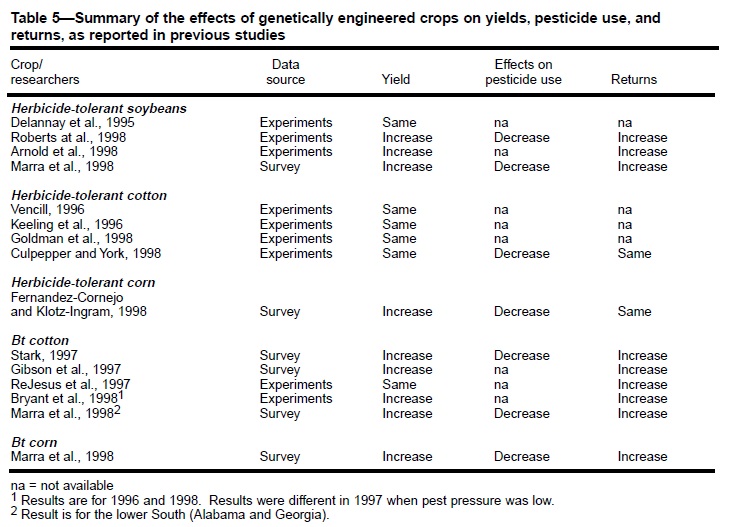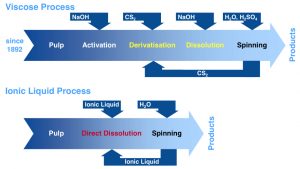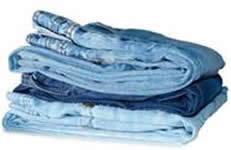The sustainability of organic cotton and GM cotton – part 2 of 2
In the first part of this article I have discussed GM cotton and organic cotton basics. In this second part I will discuss potentially unsustainable processing steps and water consumption in organic cotton, textile standards, pesticide use and yields of GM cotton vs organic cotton.
Dyes and Processing Chemicals
In further processing of the organic cotton, the classical chemical processing steps are used, for dyeing and finishing. Even if the cotton fibers were grown organically, they can still be unsustainably influenced during production by synthetic dyes and chemicals. These dyes are often involve heavy metals and volatile solvents.
For cotton, mostly reactive dyes are used, along with vat dyes (incl. indigo for blue denim), direct dyes and sulphur dyes. All these dyes are products of synthetic organic chemistry but that is not what is meant with the term “organic” in the context of organic agriculture.
 The certificate label GOTS (Global Organic Textile Standard)[18] has been created to filter the use of the least contaminating dyes and chemicals, and environmentally most favorable, current state of technology, as promoted by industry experts. But still, they are products of the chemical industry; natural dyes are practically not available on the market.
The certificate label GOTS (Global Organic Textile Standard)[18] has been created to filter the use of the least contaminating dyes and chemicals, and environmentally most favorable, current state of technology, as promoted by industry experts. But still, they are products of the chemical industry; natural dyes are practically not available on the market.
What all such certifications and labels have in common is that they give good business to certifiers and consultants, and create the illusion of more ecologically friendly products. In reality in most of the cases the same products are used as in conventional dyeing and finishing.
Some people may be surprised that GOTS allow up to 30% use of non organic fibres and moreover GOTS approved dyes and chemicals still allow heavy metals and even traces of allergenic and cancerogenic dyes (< 30 mg/kg)[18]. In general the requirements are rather industry friendly, since there is hardly a better alternative for reasonable cost available on the market.
But with this constraints at hand, the question remains: how organic are organic cotton textiles?
Higher water consumption in organic cotton
 Issues of concern of organic cotton compared to conventional and GM cotton are lower yields and higher water consumption for irrigation of cotton. Less resources, not more resources, should be used in sustainable processes. Therefore, we may ask: Is organic cotton really sustainable?
Issues of concern of organic cotton compared to conventional and GM cotton are lower yields and higher water consumption for irrigation of cotton. Less resources, not more resources, should be used in sustainable processes. Therefore, we may ask: Is organic cotton really sustainable?
“Growing cotton accounts for 2.6% of the world’s yearly water usage. One t-shirt made from conventional cotton represents 2700 liters of water, and a third of a pound of chemicals, which often contaminate water supplies”, writes Eco Fashion World[19], and “there are some drawbacks. Currently, organic cotton seems even thirstier than conventional cotton.”.
The higher water consumption is related to the lower yield per area of cultivated cotton, and mainly an issue of concern for irrigated cotton fields. It is less critical in areas with sufficient rainfall not requiring additional irrigation.
According to Cotton Inc. “It is estimated that approximately 70% of the world’s fresh water consumption is for irrigation (all crops, not just cotton), and for good reasons. Irrigation can boost yield as well as stabilize yield and quality by ensuring adequate soil water during the entire growing season”[20]
What damage irrigation in cotton agriculture can cause in dry regions of the world such as Uzbekistan, can be seen in the Aral sea in Central Asia[21]. In 1988, at the end of the Soviet Union rule, Uzbekistan was the world’s largest exporter of cotton. Today, the water level of the Aral sea is seriously depleted.
But the experience with water usage varies from field to field and from country to country, and organic cotton not always requires more water. While during the transitional phase from a conventional to organic cotton, it is common that organic cotton will require more water, however, after several years, it is reported that water usage often returns to previously normal levels[22].
Pesticide use
Some websites claim that cotton growing would account “for 10% of all agricultural chemicals, and 25% of all pesticides used worldwide every year”[19,22], others claim “cotton would be “accounting for more than 10% of total pesticide use and nearly 25% of insecticides use worldwide” [34], but typically no sources are cited to underline the numbers. In the US, cotton accounted for 7% of pesticides use in 2008, however, far behind corn and soybeans, according to USDA [35].
Especially conventionally grown cotton is a major consumer of pesticides of which the major herbicides and insecticides used are shown in the tables below.
 Organic cotton requires no pesticides, GM cotton require much less pesticides than conventionally grown cotton. Therefore, it should be expected than pesticide usage has been reduced substantially, considering the high penetration of GM cotton crops in the market. Indeed, for India, a reduced usage of cotton insecticides is reported, along with the introduction of Bt cotton[23].
Organic cotton requires no pesticides, GM cotton require much less pesticides than conventionally grown cotton. Therefore, it should be expected than pesticide usage has been reduced substantially, considering the high penetration of GM cotton crops in the market. Indeed, for India, a reduced usage of cotton insecticides is reported, along with the introduction of Bt cotton[23].
But this point of view is not unilaterally accepted, as explained osteopathic physician and health activist Dr Mercola[24] :
“The 2002 introduction of Monsanto’s genetically modified Bt cotton was supposed to lead to a reduction in the use of insecticides on cotton crops and better yields for farmers. ……But this genetically modified cotton actually required far MORE water and far MORE pesticides than hybrid or traditional cotton! These seeds were heavily marketed in India, using film stars and even religious deities to lure farmers in. And they came with a steep price tag—they are four to 10 times more expensive than hybrid seeds……Bt cotton requires more pesticide sprayings than indigenous cotton—MANY times more. Bt cotton has created new resistant pests,[8] and to control these, farmers must use 13 times more pesticides[9] than they were using prior to its introduction. Rates of infestation by aphids, thrips, jassids, and other pests have risen since Bt cotton’s introduction. Meanwhile, yields for Bt cotton are disappointingly low. Monsanto claims Bt cotton will yield 1500 kg per year, but farmers have gotten only 300 to 400 kg per year, average. High costs and unreliable output make GM cotton a debt trap.”

Yields of GM and Organic cotton fields
For GM cotton it is generally claimed that yields are improved due to more efficient pest control. According to the US Department of Agriculture several studies of the late 1990s reported higher yields and less pesticide use for GM cotton (4 of 5), especially for Bt cotton, as compared to conventional cotton[25]. Some studies reported a reduction of pesticides use, and all studies reported an increase in farm profitability.
 However, as indicated above, the yield question is controversially debated. Not everybody agrees that GM cotton has effectively higher yields. This depends on the circumstances. Reports of good yields of Organic cotton seems to be very much linked with favorable conditions, but when things turn difficult, unfavorable weather supporting pests, organic cotton may fail substantially.
However, as indicated above, the yield question is controversially debated. Not everybody agrees that GM cotton has effectively higher yields. This depends on the circumstances. Reports of good yields of Organic cotton seems to be very much linked with favorable conditions, but when things turn difficult, unfavorable weather supporting pests, organic cotton may fail substantially.
“Evidence from the studies analyzed showed that yields in well established organic farms are most often lower than conventional” says an FAO report[26] of 2009, and further “the majority of economic studies from developing countries showed higher yields for organic production, whereas not one study from developed countries showed increased yields when compared to conventional”.
A study made in California came to the conclusion “Costs of production per bale were on average 37% higher for organic than for conventional cotton. This cost differential was primarily due to greater hand-weeding costs and significantly lower yields in organic cotton”[27]
 A long-term field study in India advised by Swiss research teamcame to the conclusion that yields in GM cotton was higher than organic cotton only for the first years (“In the observation period 2007-2010, organic cotton yields were on average 14 percent lower compared to conventional cotton”), however they were found being comparable after some years[28],[29].
A long-term field study in India advised by Swiss research teamcame to the conclusion that yields in GM cotton was higher than organic cotton only for the first years (“In the observation period 2007-2010, organic cotton yields were on average 14 percent lower compared to conventional cotton”), however they were found being comparable after some years[28],[29].
Another Swiss-Indian study in 2006 even suggested lower cost and higher yields for organic cotton and found “40% lower costs for inputs, 13-20% lower variable production costs and 4-6% higher average cotton yields”[30].
In the case of India, yield improvements since the introduction of Bt cotton mainly occurred in the early years between 2002 and 2005 but only marginally since then, according to CBAN (Canadian biotechnology action network)[31]and improvements in infrastructure and hybrid seeds likewise contributed to yield increases[32].
The question is why these entirely different conclusions. Obviously there is the conflicting interest of industrial lobbyist groups and commercial interest of suppliers opposite the political agenda of environmentalist groups and their activist websites, and is it really difficult not only for the consumer, but even for brand executives and textile producers, to sort out the real hard facts.
The result, however, strongly depends on the environmental conditions, mainly the weather.
The US Dept of Agriculture stated back in 2000 “adoption of genetically engineered crops with traits for pest management has risen dramatically since their commercial introduction in the mid-1990’s. The farm-level impacts of such crops on pesticide use, yields, and net returns vary with the crop and technology examined.”25
In the last decade the market has clearly decided pro GM cotton and organic cotton has hardly penetrated the market. Can all the market be wrong? Why is India still growing mostly GM cotton, if Organic is more efficient as claimed and why is organic cotton even on the decline globally? Why is largely GM cotton used (>70% globally) and why has organic cotton an almost negligible market share (<1%)? For example, “in India, Bt cotton is mostly grown by smallholders on a total of more than 99 percent of the cotton growing area. Compared to this, the production of organic cotton is vanishingly small”[33]
Can the lobby of Monsanto and peers do such a great job so they can convince users, despite failure of GM crops, over many years to capture almost the entire market?
According to CBAN[31], “Monsanto’s virtual monopoly over the seed market means that farmers cannot find non-GM seed on the market”.
References
[1-17] listed in part 1
[18] GOTS (Global Organic Textile Standard): http://www.global-standard.org/, GOTS version 4.0 of 1.3.2014
GOTS requests: “Only textile products that contain a minimum of 70% organic fibres can become GOTS certified. All chemical inputs such as dyestuffs and auxiliaries used must meet certain environmental and toxicological criteria. … A functional waste water treatment plant is mandatory for any wet-processing unit involved and all processors must comply with minimum social criteria.”
[19] Helen Willard , 2009: “HOW THIRSTY IS YOUR TSHIRT“[20] Cotton Inc: Why Irrigate Cotton? [21] Wikipedia on Aral sea
[22] Victoria Everman : How Eco Is Organic Cotton? The Facts on 7 Questions – Is organic cotton really worth the extra cost?
[23] Monsanto: India Cotton Success, http://www.monsanto.com/improvingagriculture/pages/celebrating-bollgard-cotton-india.aspx
[24] Mercola: The “Massive Con” Causing a Suicide Every 30 Minutes
[25] Fernandez-Cornejo,J. et al. : Genetically Engineered Crops for Pest Management in U.S. Agriculture , Agricultural Economic Report No. (AER-786) 28 pp, May 2000
US Dept of Agriculture
[26] Nemes,N., FAO (Food and Agricultural Organization of the United Nations) report, 2009, page 9
[27]Sean L. Swezey, Polly Goldmana1, Janet Bryera1 and Diego Nietoa1:, Renewable Agriculture and Food Systems / Volume 22 / Issue 01 / March 2007, pp 30-40 “Six-year comparison between organic, IPM and conventional cotton production systems in the Northern San Joaquin Valley, California”, a1 Center for Agroecology and Sustainable Food Systems, University of California, Santa Cruz, CA 95064, USA.
[28] Forster,D. et al: Yield and Economical Performance of Organic and Conventional Cotton via plosone.org
[29] Long-term trial in India shows: Organic Cotton is competitive with GM crops
[30] GM watch: Study Finds Higher Yields & Lower Production Costs with Organic Cotton
[31]Genetically Modified Cotton, CBAN Factsheet
http://www.cban.ca/Resources/Topics/GE-Crops-and-Foods-On-the-Market/Cotton/Genetically-Modified-Cotton-CBAN-Factsheet
[32] Bt Cotton, Remarkable Success, and Four Ugly Facts
[33] Long-term trial in India shows: Organic Cotton is competitive with GM crops, 5.12.2013 (Research Institute of Organic Agriculture (FiBL))
[34] Pesticide action network North Amercia
[35] Pesticide Use in U.S. Agriculture: 21 Selected Crops, 1960-2008, by Jorge Fernandez-Cornejo, Richard Nehring, Craig Osteen, Seth James Wechsler, Andrew Martin, and Alex Vialou, USDA, Economic Research Service, May 2014




Sustainability of Organic cotton and GM cotton – Part 2 http://t.co/eygNS7O0IN